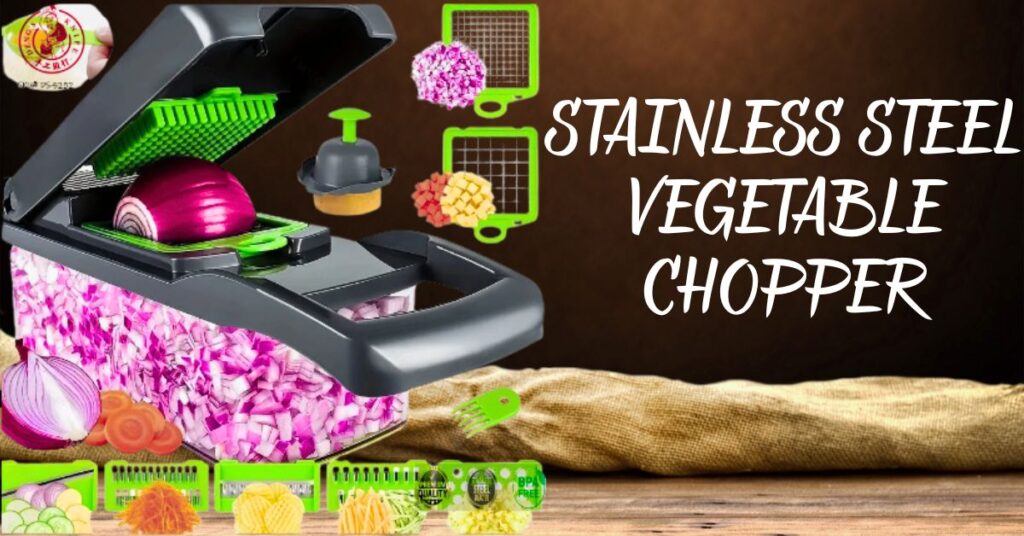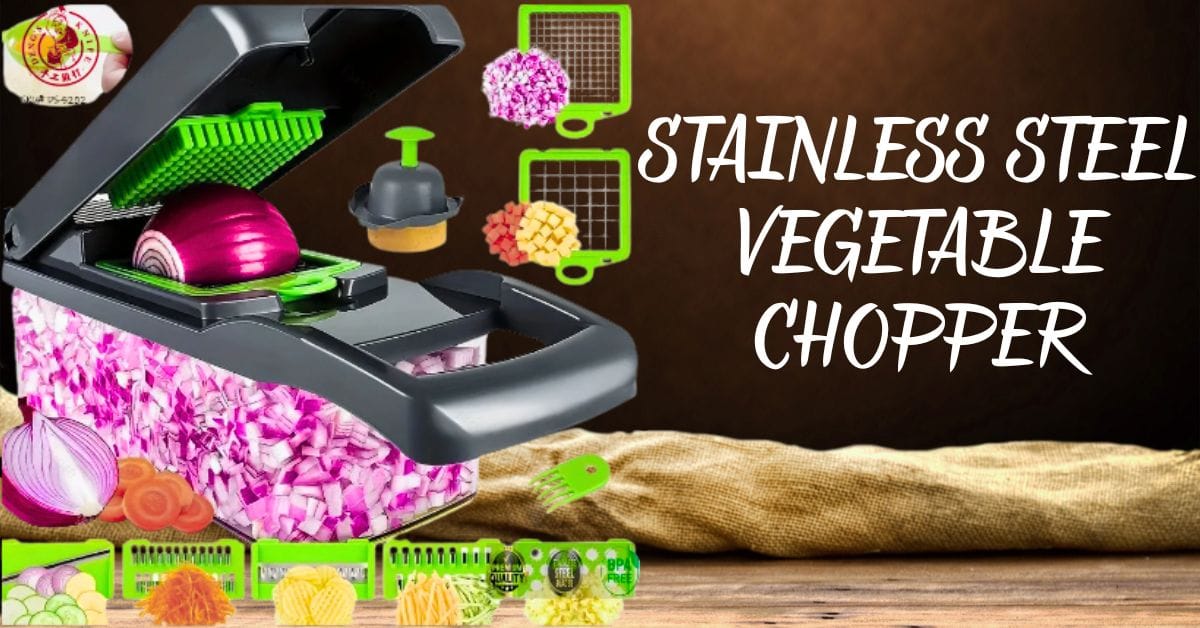I’ve found that a stainless steel vegetable chopper is key in my kitchen. It has changed how I cook, making it quicker and easier.
This kitchen tool is tough and won’t rust. It’s my top choice for cutting veggies. It’s easy to use and clean, making cooking simpler.
Having a stainless chopper saves me a lot of time in the kitchen. It’s a simple but powerful tool that’s now a part of my cooking.

Key Takeaways
- Enhances meal preparation efficiency
- Durable and rust-resistant design
- Easy to use and clean
- Reduces time spent on food preparation
- A must-have tool for home cooks
Why Every Kitchen Needs a Stainless Steel Vegetable Chopper
A stainless steel vegetable chopper is a must-have for every kitchen. It makes food prep easier and faster. Having the right tools can greatly improve your cooking experience.
Time-Saving Benefits for Busy Home Cooks
One big plus of a metal food chopper is how it saves time. Chopping veggies can be a chore, but this chopper makes it quicker. It’s perfect for those who are always in a rush to cook meals.
Also, a metal chopper chops veggies evenly. This makes your dishes look better and cook more evenly too.
Durability Advantages Over Plastic Alternatives
Stainless steel choppers last longer than plastic ones. They don’t wear out easily and don’t hold onto bacteria. So, they’re cleaner and safer for food prep.
Plus, stainless steel choppers are built to last. They’ll be in your kitchen for years, saving you money on replacements.
How Stainless Steel Vegetable Choppers Work
Learning about stainless steel vegetable choppers can make cooking better. They help chop veggies quickly and easily. This makes meal prep simpler.
Manual vs. Electric Mechanisms
These choppers are either manual or electric. Manual ones need you to push or pull to chop. Electric ones use a motor for easier chopping of more food.
Blade Technology and Design
The blades in these choppers are key to their success. They are made from strong stainless steel for clean cuts. The chopper’s design also affects how well it works.
Look for sharp blades, easy cleaning, and resistance to rust. A good chopper speeds up food prep and makes it fun. Knowing these points helps pick the right chopper for you.
Types of Stainless Steel Vegetable ChoppersAvailable Today
Stainless steel vegetable choppers come in many types, from manual to electric. They are designed to make food prep easier. Knowing the different types can help you choose the right one.
Manual Push Choppers
Manual push choppers are loved for their simplicity and effectiveness. You push the veggies through the blades by hand. This gives you control over how they’re chopped. Fullstar offers dishwasher safe manual choppers, making cleaning up a breeze.
Pull-String Choppers
Pull-string choppers chop veggies by pulling a string or handle. They are small, easy to use, and great for taking on the go. But, they might not handle big batches well.
Mandoline-Style Choppers
Mandoline-style choppers are great for precise slicing. They’re perfect for making thin, even slices. They often have adjustable blades for different thicknesses, ideal for salads or garnishes.
Electric Choppers with Stainless Components
Electric choppers with stainless steel parts make chopping easy and fast. They’re great for big batches. The Alligator food chopper is a top pick for its precision and durability.
When picking a stainless steel vegetable chopper, think about what you need. Consider how much you chop and how automated you want it. Whether manual or electric, choose one made from high-quality stainless steel for durability and easy cleaning.
Key Features to Look for in a Stainless Steel Vegetable Chopper
Choosing the right stainless steel vegetable chopper is important. It can change how you cook in the kitchen. Knowing what to look for is key.
Blade Quality and Sharpness
The blade is the core of a chopper. A stainless steel blade is durable and doesn’t rust. Sharp blades chop better and safer. Look for blades that are easy to sharpen or replace.
Container Capacity
The size of the chopper’s container matters. A bigger one lets you chop more at once, saving time. But, it takes up more space. Pick a size that fits your needs and storage.
Ease of Cleaning
How easy a chopper is to clean is important. A chopper with parts you can take off and wash in the dishwasher is best. Choose one with smooth surfaces and few places for food to hide.
Additional Attachments and Versatility
Some choppers come with extra parts. These can include different blades or attachments for other tasks. Think about what you need and pick a chopper that fits.
By looking at these features, you can find a stainless steel vegetable chopper that improves your cooking. It will meet your needs and make cooking better.
The Fullstar Vegetable Chopper: A Dishwasher Safe Option
The Fullstar Vegetable Chopper stands out among kitchen tools because it’s dishwasher safe. This feature makes it easy to clean and shows it’s designed for practical use.
Design and Construction
The Fullstar Vegetable Chopper is built to last. Its stainless steel parts are strong and durable. This means you can chop veggies efficiently without worrying about the chopper breaking.
Performance Review
The Fullstar Vegetable Chopper performs well. Its sharp blades quickly chop veggies. The design also ensures even cuts, which is great for both looks and cooking.
| Feature | Fullstar Vegetable Chopper | Competitor’s Product |
|---|---|---|
| Dishwasher Safe | Yes | No |
| Material | Stainless Steel | Plastic |
| Blade Sharpness | High | Medium |
Maintenance and Care
Cleaning the Fullstar Vegetable Chopper is a breeze. It’s dishwasher safe, and its stainless steel won’t rust or corrode. This means it lasts longer.
Key Benefits: The Fullstar Vegetable Chopper is durable, performs well, and is easy to maintain. It’s a great tool for any kitchen.
The Alligator Food Chopper: Precision and Efficiency
The Alligator Food Chopper is known for its precision and efficiency. It’s a great addition to any kitchen. It makes chopping vegetables easy, thanks to its unique features.
Unique Design Features
The Alligator Food Chopper has special design features. These include:
- A strong build for lasting use
- Ergonomic handles for easy grip
- A sharp, stainless steel blade for quick chopping
Cutting Performance
The chopper cuts vegetables evenly and quickly. This is great for making salads, slaws, and more. It saves time and effort in the kitchen.
Durability and Longevity
The Alligator Food Chopper is built to last. It’s made from top-quality materials. This means it can handle daily use for years, saving you money in the long run.
This chopper is a must-have in any kitchen. It improves your cooking, whether you’re making a simple salad or a complex dish. Its precision, efficiency, and durability make it a valuable tool.
Metal Food Choppers vs. Plastic Alternatives: A Comparative Look
Looking to improve your kitchen tools? Knowing the difference between metal and plastic food choppers is key. Your choice affects your cooking, health, and the planet.
Durability and Lifespan
Metal food choppers, like those made from stainless steel, last a long time. They can handle a lot of use without losing their shape. A chef once said, “
A good metal chopper can last you a lifetime, making it a worthwhile investment for any serious home cook.
” Metal choppers are tough and don’t break easily. They work well for a long time.
Food Safety Considerations
Metal choppers are safer than plastic ones. Stainless steel is non-porous and doesn’t scratch easily. This means it’s easy to clean and safe for food.
Because of this, metal choppers are better for making food, like raw meats and veggies.
Environmental Impact
Choosing a metal food chopper is better for the environment. They last longer and can be recycled. Plastic choppers, on the other hand, add to the plastic waste problem.
By picking a metal chopper, you use less plastic and help the planet.
In summary, metal food choppers are better than plastic ones. They’re more durable, safer for food, and better for the environment.
How to Use Your Stainless Steel Vegetable Chopper Effectively
To get the most out of your stainless steel veggie chopper, follow these guidelines. Using a stainless steel vegetable chopper can make meal prep easier.
Preparation Techniques
Before chopping, prepare your veggies. Wash, peel (if needed), and cut them into pieces that fit your chopper. For example, cut big veggies like cabbage or squash into quarters first.
Best Practices for Different Vegetables
Each veggie needs a different approach. Leafy greens like spinach can be chopped straight away. But harder veggies like carrots might need peeling and cutting into smaller bits. Knowing the best way to chop each veggie will help you get the best results.
Tips for Achieving Uniform Cuts
Getting uniform cuts is key for your dish’s look and taste. Use the right blade setting for your veggie and chop at a steady pace. This will help you get consistent cuts.
| Vegetable Type | Preparation Tip | Chopper Setting |
|---|---|---|
| Leafy Greens | Clean and dry | Fine chop |
| Root Vegetables | Peel and cut into chunks | Coarse chop |
| Hard Vegetables | Peel and cut into smaller pieces | Medium chop |
By following these tips and practicing with your stainless steel veggie chopper, you’ll get better at meal prep.
Maintenance and Care for Your Stainless Steel Veggie Chopper
Keeping your stainless steel veggie chopper in good shape is important. It helps it last longer and work better. A well-maintained chopper also keeps your food safe and prevents damage.
Cleaning Methods
Cleaning your chopper often is a must. Most are dishwasher safe, making cleaning easy. If not, a warm soapy water wash with a soft sponge works well. Make sure to dry it well to avoid water spots.
Blade Sharpening and Replacement
The blades can get dull over time. Sharpening them can make them work like new again. Some choppers come with sharpening tools. You can also use a sharpening stone. If they’re too far gone, you can easily replace them.
Storage Recommendations
Storing your chopper right is important. Keep it dry and away from other utensils that might damage it. Some choppers come with storage bags or containers. These help keep everything together.
As
“A clean kitchen is a happy kitchen,”
having a well-kept stainless steel vegetable chopper is a big part of that happiness.
Creative Recipes to Make with Your Stainless Steel Vegetable Chopper
Using a metal chopper makes cooking easy and fun. It’s not just for chopping veggies; it opens up a world of creative cooking.
Making quick salads and slaws is a great way to use it. Chopping veggies like carrots, cabbage, and cucumbers quickly makes a healthy salad.
Quick Salads and Slaws
To make a tasty slaw, I chop cabbage, carrots, and onions. Then, I mix them with a favorite dressing, like vinaigrette or creamy sauce.
Some top salad combos include:
- Kale and quinoa salad with chopped veggies
- Grilled chicken salad with bell peppers and onions
- Coleslaw with shredded cabbage and carrots
Soups and Stews
My chopper is great for soups and stews too. Chopping veggies like carrots, potatoes, and celery makes a warm, comforting dish.
Favorite soup and stew recipes are:
- Minestrone soup with veggies and beans
- Beef stew with carrots and potatoes
- Butternut squash soup with onions and garlic
Meal Prep Ideas
My chopper is also great for meal prep. Chopping a lot of veggies at once saves time during the week.
| Meal Prep Idea | Chopped Vegetables | Storage Method |
|---|---|---|
| Salad Jars | Carrots, cabbage, cucumbers | Refrigerate in airtight jars |
| Soup Containers | Carrots, potatoes, celery | Refrigerate or freeze in individual containers |
| Stir-Fry Mix | Bell peppers, onions, broccoli | Refrigerate in airtight containers |
With my stainless steel vegetable chopper, meal prep is easy. I enjoy healthy, tasty meals all week.
Common Issues with Stainless Steel Choppers and How to Solve Them
To get the most out of your stainless steel chopper, it’s key to know and fix common problems. Even though they’re tough, these choppers can face issues that lower their performance.
Blade Dullness
Blade dullness is a common problem. It can be fixed by sharpening the blades regularly. Use a sharpening stone or a sharpener to make the blades sharp again.
Cleaning the blades often is also important. This stops food bits from making the blades dull.
Sticking Mechanisms
Sticking parts can be fixed by cleaning the chopper well. Make sure to clean the moving parts carefully. A bit of oil can also help the parts move smoothly.
Rust Prevention and Treatment
To stop rust, dry your stainless steel chopper well after cleaning. If rust happens, use a gentle cleanser and a soft cloth to remove it.
By fixing these common problems, you can make your stainless steel chopper last longer. And it will keep working well.
Conclusion: Is a Stainless Steel Vegetable Chopper Right for You?
As we wrap up our look at stainless steel vegetable choppers, it’s key to think about the good and bad sides. On one hand, these choppers are long-lasting and easy to clean. They’re a great addition to any kitchen.
But, some might see the cost and the chance of blades getting dull as downsides. Think about how you cook and what veggies you usually chop.
If you want a dependable way to chop veggies, a stainless steel vegetable chopper is a good choice. Check out the different models and read what others say.
Ready to improve your kitchen with a stainless steel vegetable chopper? Find out more about the various options and pick the best one for you.
Questions and Answers
Many home cooks wonder about stainless steel vegetable choppers. We’re here to help. These tools are popular for their durability and efficiency in the kitchen.
Here are some common questions about stainless steel vegetable choppers:
| Question | Answer |
|---|---|
| Are stainless steel vegetable choppers easy to clean? | Yes, most stainless steel vegetable choppers are dishwasher safe. This makes cleaning easy and convenient. |
| Can I chop all types of vegetables with a stainless steel chopper? | Stainless steel choppers are versatile. You can use them for many vegetables, from soft leafy greens to harder root vegetables. |
| How do I maintain the blade of my stainless steel chopper? | Regular sharpening and proper storage help keep the blade sharp and long-lasting. |
Understanding the benefits and care of stainless steel vegetable choppers can improve your cooking. It makes meal prep more efficient.
FAQ
What are the benefits of using a stainless steel vegetable chopper?
A stainless steel vegetable chopper saves time and is durable. It’s also easy to clean. Plus, it’s healthier because it doesn’t hold bacteria like other materials.
Are stainless steel vegetable choppers dishwasher safe?
Some, like the Fullstar vegetable chopper, are dishwasher safe. This makes cleaning a breeze. But, always check the manufacturer’s instructions first.
What types of stainless steel vegetable choppers are available?
There are many types. You can find manual push choppers, pull-string choppers, mandoline-style choppers, and electric choppers with stainless parts.
How do I maintain my stainless steel veggie chopper?
To keep your chopper in good shape, clean it often. Sharpen or replace the blades when needed. Also, store it right to avoid rust.
Can I use a stainless steel vegetable chopper for other foods beside vegetables?
Yes, you can chop fruits, nuts, and herbs with many stainless steel choppers. They’re very versatile in the kitchen.
What should I look for when buying a stainless steel vegetable chopper?
Look at the blade quality, how much it can hold, and how easy it is to clean. Also, consider if it comes with extra attachments for more uses.
Are metal food choppers better than plastic alternatives?
Metal choppers, like stainless steel ones, are more durable and safer than plastic. They also last longer and are better for the environment.
How do I prevent rust on my stainless steel chopper?
To stop rust, clean and dry your chopper well after each use. Then, store it in a dry spot.
Disclaimer
This article is for general use only. It’s not meant to be a complete guide. We’ve tried to make the information accurate, but it can change anytime.
Using any product or brand name here is just for example. It doesn’t mean we endorse them.
Readers should check the facts themselves before buying or acting. This article is not professional advice. Any use of the info is at your own risk.


